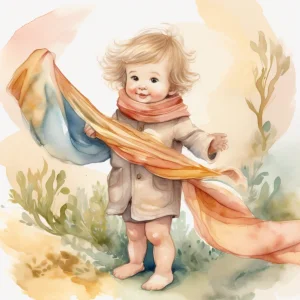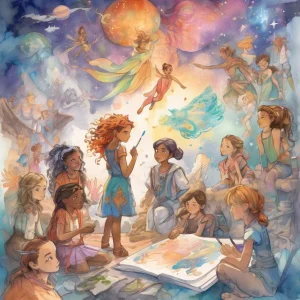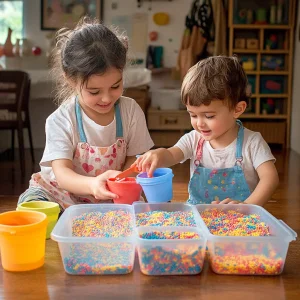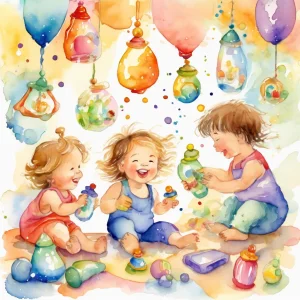Activity
Similar Activities
Musical Painting Fun: Expressive Art and Melodies
Children’s Age: 2–3 years
Activity Duration: 10 – 30 minutes
This activity involves children creating paintings while listening to music that matches the mood of sentences they choose. It helps with sensory development, and social-emotional …
Activity Duration: 10 – 30 minutes
Enchanted Nature-Based Storytelling Adventure
Children’s Age: 0 month – 6 years
Activity Duration: 5 – 10 minutes
Let's have fun with Nature-Based Storytelling! Find a cozy outdoor spot, lay down a blanket, and bring a basket for collecting leaves and stones. Sit with your child, explore natur…
Activity Duration: 5 – 10 minutes
Enchanted Infant Sensory Exploration with Household Items
Children’s Age: 3 – 9 months
Activity Duration: 10 minutes
Engage infants aged 3 to 9 months in a sensory exploration activity using common household items. Set up a safe area with soft fabrics, a wooden spoon, a baby-safe mirror, and more…
Activity Duration: 10 minutes
Textures and Movements: Sensory Scarf Play Activity
Children’s Age: 6 months – 1.5 years
Activity Duration: 10 minutes
The sensory scarf play activity is designed for children aged 6 to 18 months to support motor development through texture exploration. Using various textured scarves in a safe play…
Activity Duration: 10 minutes
Enchanted Storybook Illustration Adventure
Children’s Age: 6–10 years
Activity Duration: 25 minutes
Engage children aged 6 to 10 in the "Storybook Illustration Adventure" for a creative and language-rich experience. Gather drawing materials and set up individual workspaces to ill…
Activity Duration: 25 minutes
Harmonious Harmony: Musical Money Makers Adventure
Children’s Age: 11–15 years
Activity Duration: 1 hour
"Musical Money Makers" is a fun and educational activity that boosts language development, empathy, economic understanding, and creativity using music and instruments. Set up by ga…
Activity Duration: 1 hour
Wonderful Beginnings: The Sensory Nature Walk
Children’s Age: 0 – 3 months
Activity Duration: 5 – 10 minutes
Experience a calming and stimulating Sensory Nature Walk designed for infants aged 0 to 3 months. Prepare with a soft carrier, cozy blanket, sunscreen, and a nature sounds playlist…
Activity Duration: 5 – 10 minutes
Cosmic Conundrum Chefs: Space Word Problem Adventure
Children’s Age: 7–8 years
Activity Duration: 10 – 20 minutes
Let's play Space Word Problem Chefs! We'll use paper, pencils, and space-themed stickers to explore language and problem-solving. Set up a cozy spot, grab your supplies, and get re…
Activity Duration: 10 – 20 minutes
Magical Storytelling: Create Together with Friends
Children’s Age: 4–6 years
Activity Duration: 15 – 30 minutes
In the Create a Story Together activity, children will explore their creativity, language skills, and teamwork. Get small pieces of paper, colored pencils, and a container ready. K…
Activity Duration: 15 – 30 minutes
Whimsical Cup Blow Race for Kids
Children’s Age: 4–6 years
Activity Duration: 5 – 10 minutes
The Cup Race Challenge activity is designed to boost teamwork, fine motor skills, and problem-solving in children. You'll need plastic cups, straws, a table, and masking tape to cr…
Activity Duration: 5 – 10 minutes
Rainbow Rice Sensory Play Adventure
Children’s Age: 1.5–2 years
Activity Duration: 10 minutes
Engage toddlers aged 18 to 24 months in a sensory play activity using colored rice to enhance physical, social-emotional, and sensory development. Gather materials like uncooked wh…
Activity Duration: 10 minutes
Musical Discovery: Sensory Sound Bottles Adventure
Children’s Age: 6 months – 1.5 years
Activity Duration: 5 – 10 minutes
Engage your child aged 6 to 18 months with the Sensory Sound Bottles activity, promoting self-care skills and language development. Using clear plastic water bottles and various so…
Activity Duration: 5 – 10 minutes




























